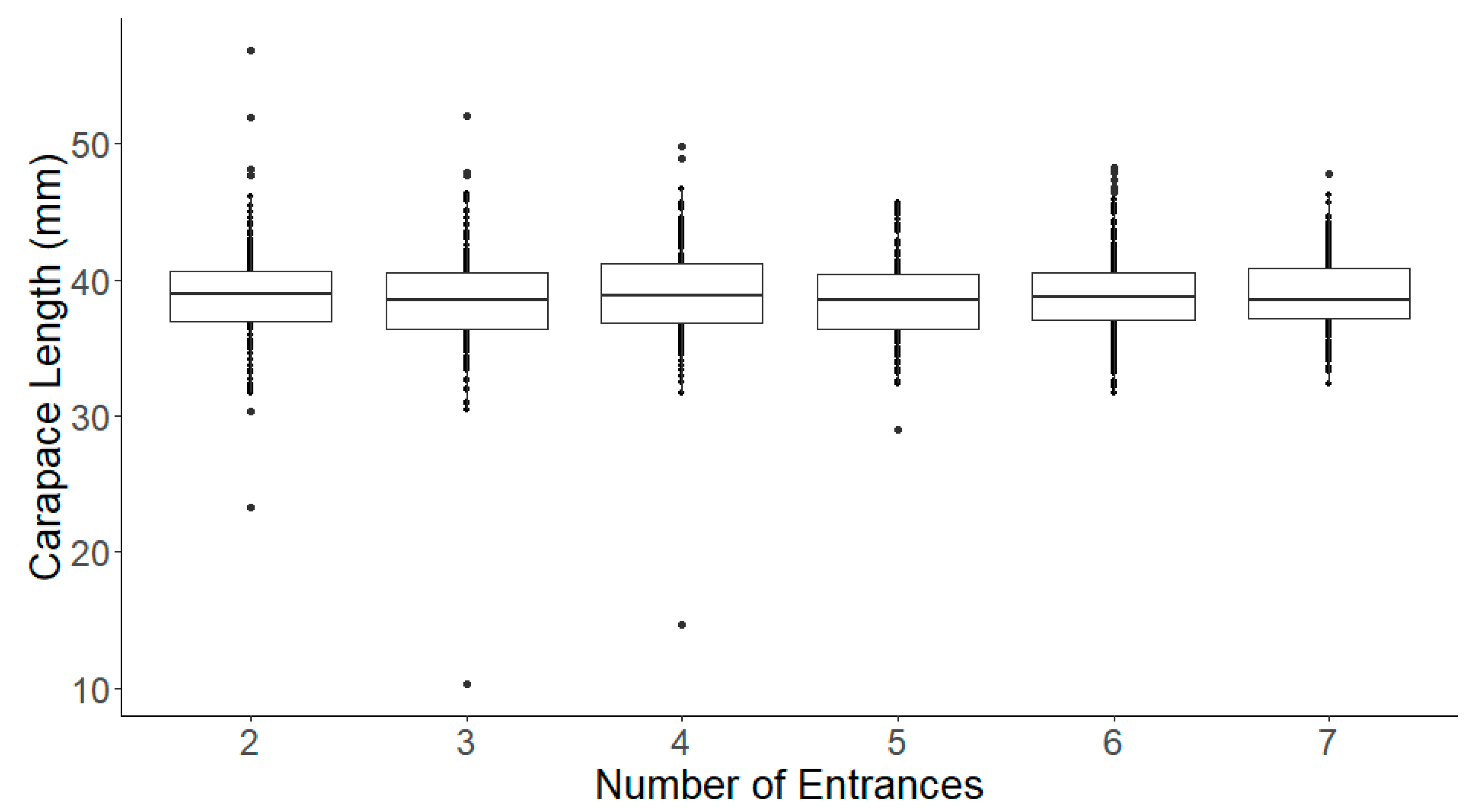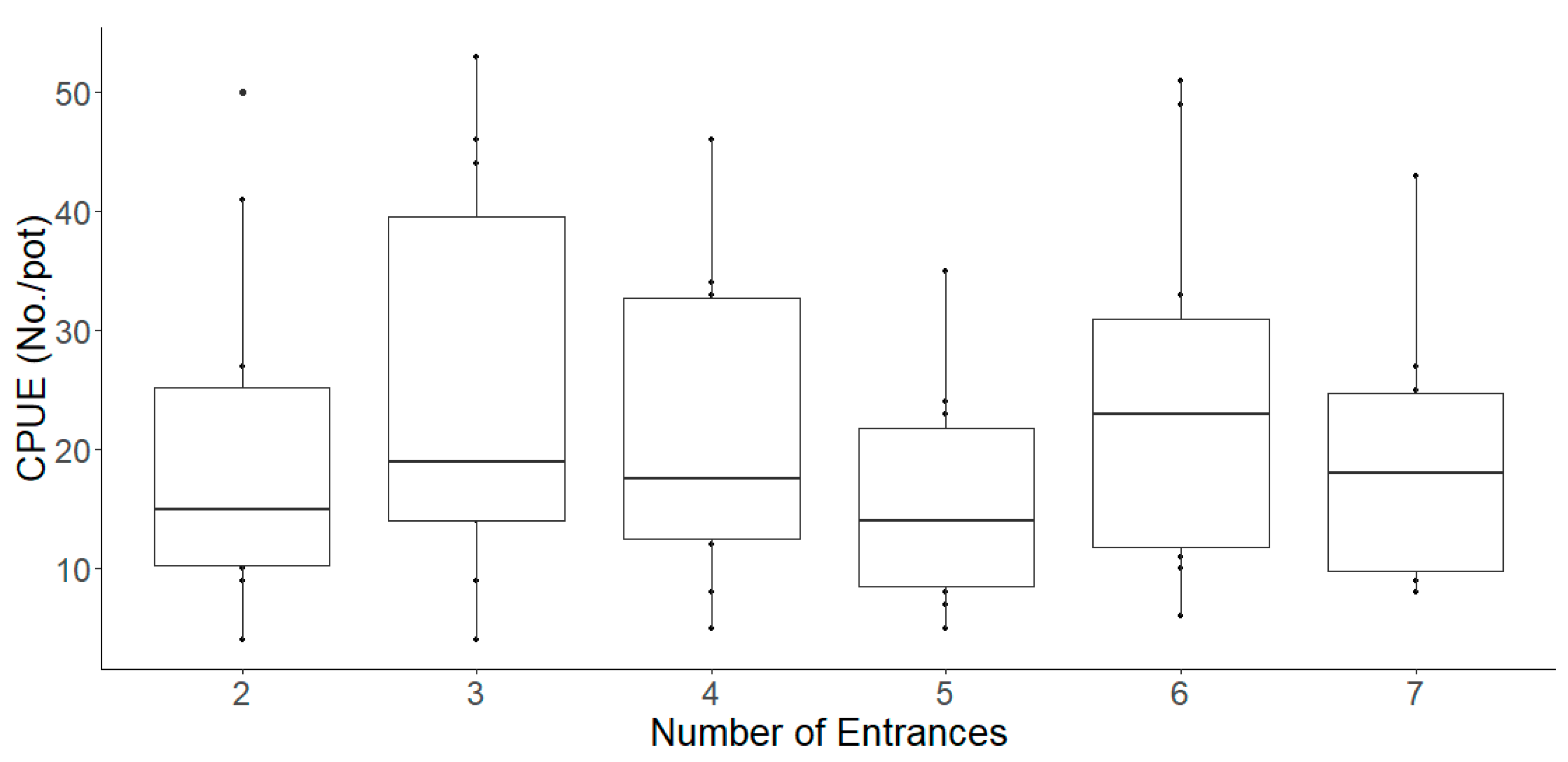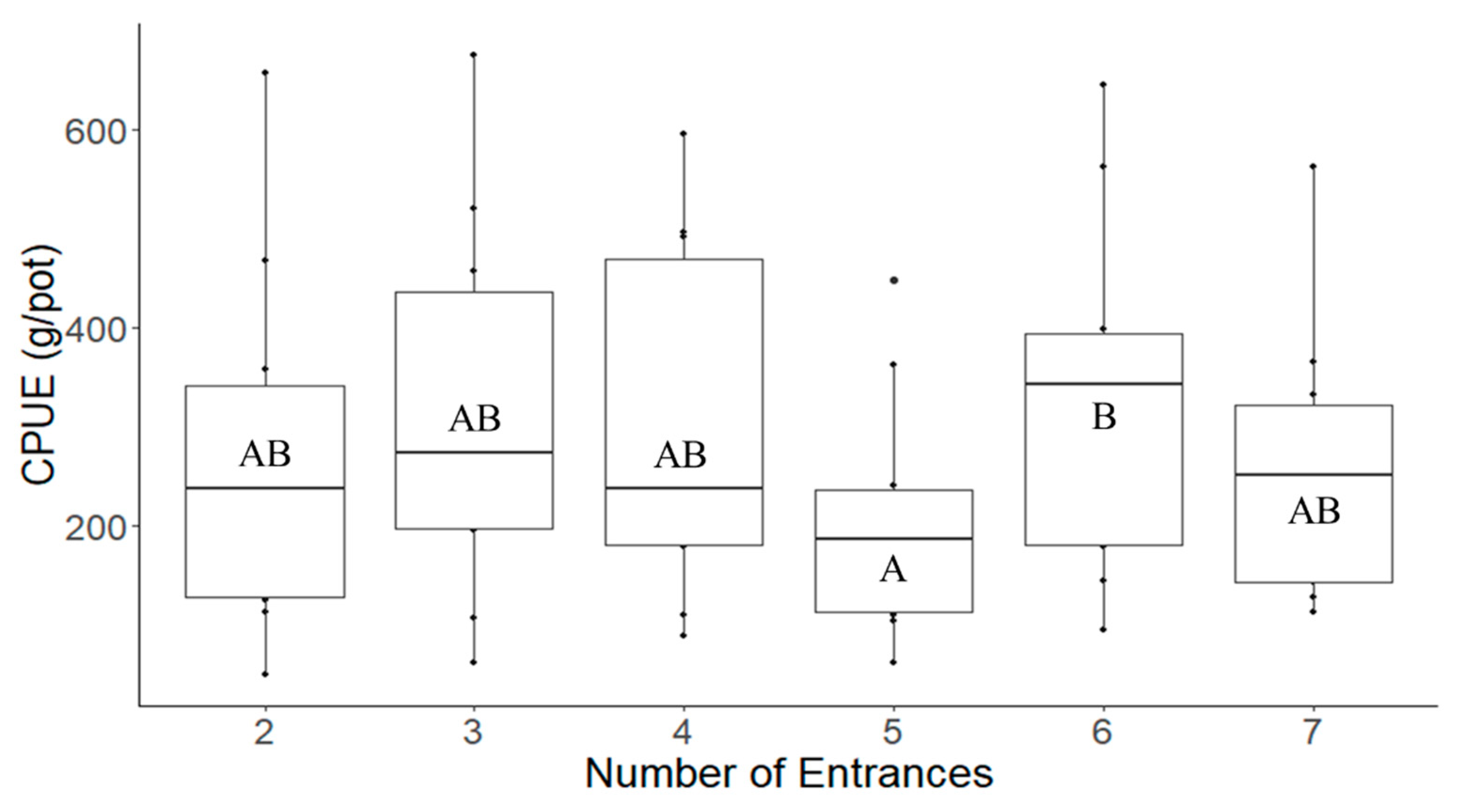Comparing Catch Efficiency of Crayfish (Procambarus clarkii) Traps with Different Entrance Numbers
Abstract
:1. Introduction
2. Material and Methods
3. Results
4. Discussion
Author Contributions
Funding
Institutional Review Board Statement
Informed Consent Statement
Data Availability Statement
Acknowledgments
Conflicts of Interest
References
- Oficialdegui, F.J.; Sánchez, M.I.; Clavero, M. One century away from home: How the red swamp crayfish took over the world. Rev. Fish Biol. Fish. 2020, 30, 121–135. [Google Scholar] [CrossRef]
- Yue, G.H.; Li, J.; Bai, Z.; Wang, C.M.; Feng, F. Genetic diversity and population structure of the invasive alien red swamp crayfish. Biol. Invasions 2010, 12, 2697–2706. [Google Scholar] [CrossRef]
- Wang, C.; Li, Z.; Liang, H.; Hu, G.; Wu, Q.; Zou, G.; Luo, X. Genetic diversity in four Procambarus clarkia populations in the lower reaches of the Yangtze River. Biodivers. J. 2009, 17, 518. [Google Scholar]
- Wang, Q.; Ding, H.; Tao, Z.; Ma, D. Crayfish (Procambarus clarkii) Cultivation in China: A Decade of Unprecedented Development. In Aquaculture in China; John Wiley & Sons Ltd.: Chichester, UK, 2018; pp. 363–377. [Google Scholar]
- Ministry of Agriculture and Rural Affairs of the People’s Republic of China. China Crayfish Industry Development Report; Ministry of Agriculture and Rural Affairs of the People’s Republic of China: Beijing, China, 2021; Volume 7, pp. 27–33. (In Chinese)
- Farrag, M.M.S.; El-Geddawy, M.A.; Ahmed, Z.S.A. More evidences for the nutritional quality and future exploitation of the invasive crayfish Procambarus clarkii (Girard, 1852) from the River Nile, Egypt. Egypt. J. Aquat. Res. 2022, 48, 151–156. [Google Scholar] [CrossRef]
- Hady, F.; Deeb, R.; Saad, A.; Rahman, F. Effect of partial or total replacement of fish meal with Procambarus clarkii by-product meal in Oreochromis niloticus diets. Egypt. J. Exp. Biol. 2019, 15, 277. [Google Scholar] [CrossRef]
- Sara, S.; Abdelouahab, S.; Ahcen, M.; Habib, E.J.; Majida, E.A.E.M. Socioeconomic impact following the introduction of the red swamp crayfish Procambarus clarkii (Girard, 1852) in Morocco. Int. J. Adv. Eng. Sci. Appl. Math. 2020, 9, 8–17. [Google Scholar]
- Kvistad, J.; Galarowicz, T.; Clapp, D.; Chadderton, L.; Tucker, A.; Herbert, M. An evaluation of three trap designs for invasive rusty crayfish (Faxonius rusticus) suppression on critical fish spawning habitat in northern Lake Michigan. Manag. Biol. Invasions 2021, 12, 975–996. [Google Scholar] [CrossRef]
- Stevens, B.G. The ups and downs of traps: Environmental impacts, entanglement, mitigation, and the future of trap fishing for crustaceans and fish. ICES J. Mar. Sci. 2020, 78, 584–596. [Google Scholar] [CrossRef]
- Bills, T.D.; Marking, L.L. Control of Nuisance Populations of Crayfish with Traps and Toxicants. Progress. Fish-Cult. 1988, 50, 103–106. [Google Scholar] [CrossRef]
- Larson, E.R.; Olden, J.D. The State of Crayfish in the Pacific Northwest. Fisheries 2011, 36, 60–73. [Google Scholar] [CrossRef]
- Suuronen, P.; Chopin, F.; Glass, C.; Løkkeborg, S.; Matsushita, Y.; Queirolo, D.; Rihan, D. Low impact and fuel efficient fishing–Looking beyond the horizon. Fish. Res. 2012, 135–146. [Google Scholar] [CrossRef]
- Richardson, K.; Hardesty, B.D.; Wilcox, C. Estimates of fishing gear loss rates at a global scale: A literature review and meta-analysis. Fish Fish. 2019, 20, 1218–1231. [Google Scholar] [CrossRef]
- Uhlmann, S.S.; Broadhurst, M.K. Mitigating unaccounted fishing mortality from gillnets and traps. Fish Fish. 2013, 16, 183–229. [Google Scholar] [CrossRef]
- Nguyen, K.Q.; Morris, C.J. Fishing for Atlantic cod (Gadus morhua) with pots and gillnets: A catch comparison study along the southeast coast of Labrador. Aquac. Fish. 2022, 7, 433–440. [Google Scholar] [CrossRef]
- Leland, J.C.; Butcher, P.A.; Broadhurst, M.K.; Paterson, B.D.; Mayer, D.G. Relative trap efficiency for recreationally caught eastern Australian blue swimmer crab (Portunus pelagicus) and associated injury and mortality of discards. Fish. Res. 2013, 147, 304–311. [Google Scholar] [CrossRef]
- Huner, J.V.; Paret, J. Trap harvest of crawfish (Procambarus spp.) from a South Louisiana commercial pond: Effectiveness of different baits and species composition. Freshw. Crayfish 1995, 8, 376–390. [Google Scholar]
- Winger, P.D.; Walsh, P.J. Selectivity, efficiency, and underwater observations of modified trap designs for the snow crab (Chionoecetes opilio) fishery in Newfoundland and Labrador. Fish. Res. 2011, 109, 107–113. [Google Scholar] [CrossRef]
- Bechler, D.; Hightower, P.; Rousy, J.; Smith, M. The use of nest-traps to study behavior, population structure and li fe history of Procambarus spiculifer. Freshw. Crayfish 2014, 20, 7–16. [Google Scholar] [CrossRef]
- Parkyn, S.; DiStefano, R.; Imhoff, E. Comparison of constructed microhabitat and baited traps in Table Rock Reservoir, Missouri, USA. Freshw. Crayfish 2011, 18, 69–74. [Google Scholar] [CrossRef]
- Tran, P.D.; Nguyen, L.T.; To, P.V.; Nguyen, K.Q. Effects of the trap entrance designs on the catch efficiency of swimming crab Charybdis feriata fishery. Fish. Res. 2020, 232, 105730. [Google Scholar] [CrossRef]
- Meintzer, P.; Walsh, P.; Favaro, B. Comparing catch efficiency of five models of pot for use in a Newfoundland and Labrador cod fishery. PLoS ONE 2018, 13, e0199702. [Google Scholar] [CrossRef] [PubMed]
- Folkins, M.H. Using Underwater Video Observations to Improve Capture Efficiency of Fishing Gear. Master’s Thesis, Memorial University of Newfoundland, St. John’s, Canada, 2019. [Google Scholar]
- Bergshoeff, J.A.; McKenzie, C.H.; Favaro, B. Improving the efficiency of the Fukui trap as a capture tool for the invasive European green crab (Carcinus maenas) in Newfoundland, Canada. PeerJ 2019, 7, e6308. [Google Scholar] [CrossRef] [PubMed] [Green Version]
- Anders, N.; Fernö, A.; Humborstad, O.-B.; Løkkeborg, S.; Utne-Palm, A.C. Species specific behaviour and catchability of gadoid fish to floated and bottom set pots. ICES J. Mar. Sci. 2016, 74, 769–779. [Google Scholar] [CrossRef]
- Anders, N. The Effect of Pot Design on Behaviour and Catch Efficiency of Gadoids. Master’s Thesis, The University of Bergen, Bergen, Norway, 2015. [Google Scholar]
- R Development Core Team. R: A Language and Environment for Statistical Computing. Vienna, Austria. 2009. Available online: http://www.R-project.org (accessed on 8 December 2021).
- Harrison, X.A.; Donaldson, L.; Correa-Cano, M.E.; Evans, J.; Fisher, D.N.; Goodwin, C.E.D.; Robinson, B.S.; Hodgson, D.J.; Inger, R. A brief introduction to mixed effects modelling and multi-model inference in ecology. PeerJ 2018, 6, e4794. [Google Scholar] [CrossRef] [Green Version]
- Bates, D.; Maechler, M.; Bolker, B.; Walker, S. lme4: Linear Mixed-Effects Models Using Eigen and S4. R Package Version 1.1–7. 2014. Available online: http://CRAN.R-project.org/package=lme4 (accessed on 8 December 2021).
- Nakagawa, S.; Schielzeth, H. A general and simple method for obtaining R2 from generalized linear mixed-effects models. Methods Ecol. Evol. 2012, 4, 133–142. [Google Scholar] [CrossRef]
- Barton, K. Mu-MIn: Multi-Model Inference. R Package Version 0.12.2/r18. Available online: http://R-Forge.R-project.org/projects/mumin/ (accessed on 8 December 2021).
- Cheng, Z.; Winger, P.D.; Bayse, S.M.; Kebede, G.E.; DeLouche, H.; Einarsson, H.A.; Pol, M.V.; Kelly, D.; Walsh, S.J. Out with the Old and in with the New: T90 Codends Improve Size Selectivity in the Canadian Redfish (Sebastes Mentella) Trawl Fishery. Can. J. Fish. Aquat. Sci. 2020, 77, 1711–1720. [Google Scholar] [CrossRef]
- Wileman, D.A.; Council, I. Manual of Methods of Measuring the Selectivity of Towed Fishing Gears. ICES Coop. Res. Rep. 1996, 215, 1–216. [Google Scholar]
- Folkins, M.H.; Grant, S.M.; Walsh, P. A feasibility study to determine the use of baited pots in Greenland halibut (Reinhardtius hippoglossoides) fisheries, supported by the use of underwater video observations. PeerJ 2021, 9, e10536. [Google Scholar] [CrossRef]
- Araya-Schmidt, T.; Olsen, L.; Rindahl, L.; Larsen, R.B.; Winger, P.D. Alternative bait trials in the Barents Sea snow crab fishery. PeerJ 2019, 7, e6874. [Google Scholar] [CrossRef]
- Jørgensen, T.; Løkkeborg, S.; Furevik, D.; Humborstad, O.B.; De Carlo, F. Floated cod pots with one entrance reduce probability of escape and increase catch rates compared with pots with two entrances. Fish. Res. 2017, 187, 41–46. [Google Scholar] [CrossRef]
- García-de-Lomas, J.; Dana, E.D.; González, R. Traps and netting, better together than alone: An innovative approach to improve Procambarus Clarkii management. Knowl. Manag. Aquat. 2020, 421, 39. [Google Scholar] [CrossRef]
- Budnick, W.; Roth, B.; Nathan, L.; Thomas, S.; Smith, K.; Walker, S.; Herbst, S. Evaluation of Five Trap Designs for Removal of Invasive Red Swamp Crayfish (Procambarus Clarkii Girard, 1852) in Southern Michigan: Catch per Unit Effort, Body Size, and Sex Biases. Manag. Biol. Invasions 2022, 13, 369–390. [Google Scholar] [CrossRef]
- De Palma-Dow, A.; Curti, J.; Fergus, E. It’s a Trap! An Evaluation of Different Passive Trap Types to Effectively Catch and Control the Invasive Red Swamp Crayfish (Procambarus Clarkii) in Streams of the Santa Monica Mountains. Manag. Biol. Invasions 2020, 11, 44–62. [Google Scholar] [CrossRef] [Green Version]
- Figler, M.H.; Finkelstein, J.E.; Twum, M.; Peeke, H.V.S. Intruding male red swamp crayfish, Procambarus clarkii, immediately dominate members of established communities of smaller, mixed-sex conspecifics. Aggress. Behav. 1995, 21, 225–236. [Google Scholar] [CrossRef]
- Hedgärde, M.; Berg, C.W.; Kindt-Larsen, L.; Lunneryd, S.G.; Königson, S. Explaining the catch efficiency of different cod pots using underwater video to observe cod entry and exit behaviour. J. Ocean Technol. 2016, 11, 67–90. [Google Scholar]




| Dependent Variable | Marginal Pseudo-R2 | Conditional Pseudo-R2 | Random Variables | Fixed Variables | Estimate | Std. Error | z/t Value | p-Value |
|---|---|---|---|---|---|---|---|---|
| CL | 0.005 | 0.123 | Date | Intercept | 39.220 | 0.406 | 96.534 | <0.001 |
| En3 | −0.260 | 0.287 | −0.907 | 0.406 | ||||
| En4 | 0.133 | 0.295 | 0.454 | 0.669 | ||||
| En5 | −0.499 | 0.319 | −1.566 | 0.178 | ||||
| En6 | 0.104 | 0.290 | 0.359 | 0.734 | ||||
| En7 | −0.068 | 0.303 | −0.225 | 0.831 | ||||
| CPUEN | 0.048 | 0.769 | Date | Intercept | 2.845 | 0.203 | 14.014 | <0.001 |
| En3 | 0.197 | 0.143 | 1.378 | 0.168 | ||||
| En4 | 0.082 | 0.145 | 0.565 | 0.572 | ||||
| En5 | −0.200 | 0.151 | −1.327 | 0.185 | ||||
| En6 | 0.205 | 0.143 | 1.431 | 0.152 | ||||
| En7 | −0.031 | 0.147 | −0.216 | 0.829 | ||||
| CPUEW | 0.057 | 0.752 | Date | Intercept | 267.300 | 53.720 | 4.976 | 0.004 |
| En3 | 46.400 | 38.930 | 1.192 | 0.287 | ||||
| En4 | 34.600 | 38.930 | 0.889 | 0.415 | ||||
| En5 | −63.000 | 38.930 | −1.618 | 0.167 | ||||
| En6 | 60.500 | 38.930 | 1.554 | 0.181 | ||||
| En7 | −9.300 | 38.930 | −0.239 | 0.821 |
Publisher’s Note: MDPI stays neutral with regard to jurisdictional claims in published maps and institutional affiliations. |
© 2022 by the authors. Licensee MDPI, Basel, Switzerland. This article is an open access article distributed under the terms and conditions of the Creative Commons Attribution (CC BY) license (https://creativecommons.org/licenses/by/4.0/).
Share and Cite
Cheng, Z.; Folkins, M.H.; Huang, L.; Li, Y. Comparing Catch Efficiency of Crayfish (Procambarus clarkii) Traps with Different Entrance Numbers. J. Mar. Sci. Eng. 2022, 10, 1708. https://doi.org/10.3390/jmse10111708
Cheng Z, Folkins MH, Huang L, Li Y. Comparing Catch Efficiency of Crayfish (Procambarus clarkii) Traps with Different Entrance Numbers. Journal of Marine Science and Engineering. 2022; 10(11):1708. https://doi.org/10.3390/jmse10111708
Chicago/Turabian StyleCheng, Zhaohai, Margaret H. Folkins, Liuyi Huang, and Ye Li. 2022. "Comparing Catch Efficiency of Crayfish (Procambarus clarkii) Traps with Different Entrance Numbers" Journal of Marine Science and Engineering 10, no. 11: 1708. https://doi.org/10.3390/jmse10111708




